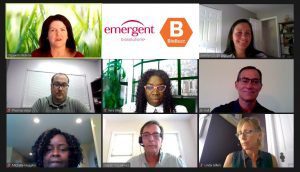
How Life Science Job Seekers Use Personal Branding to Attract Top Employers
Mining job posting sites and carpet bombing potential life sciences employers with your CV and a cover letter is an antiquated approach to landing your next dream job. Relying on this job search method alone will result in your CV getting lost among the morass of job candidates jockeying for attention and the opportunity to interview.
The job search and employer hiring strategy ecosystem has become much more dynamic in the last five years; this dynamism and complexity have only accelerated with the disruptions caused by the pandemic that is still rippling throughout the labor market.
A dynamic job search environment requires an equally bold and dynamic approach to
your job search.
Employers are increasingly leveraging social media, digital recruiting events, and virtual interviews to locate, attract, and secure that talent they need to support their respective organization’s growth strategies. In addition, more and more life sciences companies are investing in employer branding, which is the active, intentional, and strategic projection of a given company’s culture, values, mission, and employee development opportunities across multiple media channels, including virtual conferences, social media channels, and traditional job search sites. In other words, employers are starting to be more intentional about telling their stories and creating a narrative across myriad digital platforms.
What does this mean for you as a talented life sciences professional?
Whether you’re a passive candidate, meaning you’re employed and not actively seeking a new job, or you’re out of work and aggressively pursuing opportunities, you need to proactively keep your personal brand in front of potential hiring managers and possible future employers.
This means adopting a multi-channel approach to marketing your skills and telling your personal narrative. Yes, it seems more efficient to mass send your CV using job posting sites like Indeed and Glassdoor, for example. However, the current job search playing field requires putting your personal brand out there in new and perhaps unfamiliar ways.
What exists today is a hybrid networking world ripe with potential for both passive and active job candidates.
“You aren’t limited by physical distance anymore to network, gain insights, and training or to connect with other professionals with similar interests. It’s this idea that you can connect digitally, you can hop on a ZOOM call, you can hop on any of these awesome platforms where people are going online, interactive, and engaging in discussions from anywhere,” stated Jake Thomas, Director of Employer Brand & Talent Communities at Workforce Genetics.
“And now we’re getting back now, we’re starting to have in-person events, and we’re going to see this duality taking place where some events are digital, and some are in person,” he added.
One of the ways job seekers and biopharma professionals can do this is by taking advantage of in-person or digital thought leadership opportunities. Thought leadership events, conference panels, videos, or posts are a great way to showcase your skills to potential employers; sticking your proverbial “neck” out into the public sphere tells employers that you’re serious, proactive, and aware of the evolving job search arena. Additionally, job candidates that leverage networking sites like LinkedIn regularly but who also engage in thought leadership content creation will meet potential employers where they live, just as employers are attempting to connect with great life sciences’ talent in the digital and networking habitats frequent most.
The goal of thought leadership activities is to showcase your technical and soft skills and to create a platform where your personal brand and an employer brand can connect and explore possibilities.
“First and foremost, a thought leadership opportunity can be anything. It’s about this software developer concept of open source and putting out ways that we solve problems in a digestible way that can be applied to other problems. It can be an article, a video, or participating in an event,” stated Thomas.
“When candidates are putting out thought leadership content, it is demonstrating to potential employers that this person is an expert; you can see how they think and how they solve problems; doing thought leadership well can make a candidate more attractive. Identify what platforms you want to go after and your sweet spot and go after it,” he added.
Engaging in thought leadership might seem like a risk, but the rewards can be well worth it when done well and strategically. Solid thought leadership content shared on the right venue will showcase your passion, willingness to engage, and entrepreneurial risk-taking spirit with high value for talent managers.
“A great leading indicator of how successful a job candidate will be is their willingness to take risks and their openness to try something and fail. When you engage in thought leadership and put ideas out there, you’re going to be challenged, and the boldness to do this is an element of what hiring managers look for in candidates,” shared Thomas.
That said, when you begin engaging thought leadership content opportunities, you need to be thoughtful about your approach. Make sure you do the following before going public with any thought leadership content:
- Make sure to stay within your level/area of expertise; stay within your bailiwick
- Understand the audience you’re engaging
- Understand the platform (article, video, in-person event) and its environment
- Be prepared
- Be authentic
You can engage in thought leadership content regardless of where you are in your career. If you are early in your research career, perhaps you can create short “how-to” video content and post the video on LinkedIn, for example; if you’re a senior manager or director, a panel discussion at a virtual or in-person conference might be a great fit; and if you’re in the C-Suite, keynoting major conferences or TV media engagements could fit the bill. The important item to remember is that thought leadership can be a valuable tool for all stages of your career; the key is ensuring you don’t overstate or overextend your level of experience and expertise.
Make sure your thought leadership content is an authentic match for your experience and skill level.
“You need to utilize discretion. You need to know what you don’t know, but you can also take some calculated risks. The whole idea of thought leadership has been disrupted in the last three years. Audiences are softening to accepting more voices and that there are a lot of different ways to have expertise,” shared Thomas.
“Leverage network effects and platforms with built-in audiences. Make sure you control the content as well so you can post it on your own digital sites. You can build the wheel yourself or improve upon the wheel that already exists,” added Thomas. “You can partner with someone to utilize their platform and connect with their audience.”
Being active in the thought leadership space can have great value to passive and active job candidates. Still, it is also just one facet of a multi-channel approach to building a personal career brand that is attractive and out front of your target employers.
As a life sciences professional, it is imperative to invest the time and brainpower to build your network, stay actively engaged with the biopharma community, and share your expertise across multiple touchpoints on a consistent basis.
The new hybrid networking world requires a dynamic networking and job search strategy to avoid being buried within a deep, digital sea of resumes and cover letters. Engaging in thought leadership as one component of a multi-faced networking strategy increases the chances of your personal brand finding that ideal employer brand that will accelerate your career.
- About the Author
- Latest Posts
Steve brings nearly twenty years of experience in marketing and content creation to the WorkForce Genetics team. He loves writing engaging content and working with partners, companies, and individuals to share their unique stories and showcase their work. Steve holds a BA in English from Providence College and an MA in American Literature from Montclair State University. He lives in Frederick, Maryland with his wife, two sons, and the family dog.








